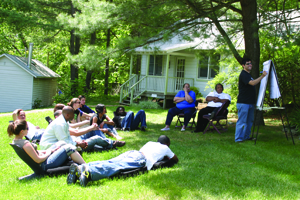Just over one year ago, on February 18, 2011, Planned Parenthood Federation of America launched the largest integrated campaign in its history. The threat to defund Planned Parenthood was bundled in a larger packaged proposal of funding cuts to be voted on in Washington, D.C., though the exact date of the vote was unknown. Planned Parenthood launched a multi-channel campaign to ask supporters to stand with them, and at the 2012 SXSWi festival, they shared the three biggest lessons they learned as an organization from the process.
The first: Prime your community so they will be there when you need them. Nakia Hansen, now the Director of Social Media Strategy at The College Board, suggests that social media is a great way to do this. "We did it on Facebook and Twitter and YouTube by posting content they could remix or make their own, or just re-share what was posted by others." Gabriela Lazzaro, now an Engagement Planner at iCrossing, believes engaging different audiences really requires transparency. "When the crisis happened, we already had education and information available on all of our channels in multiple languages so there was information to point people to." Social channels were used to build up community and create a consistent space for engagement between the organization and individuals as well as amongst the community. "We weren’t asking for things on a daily basis, but just maintaining an open dialogue," said Lazzaro. "It’s all about building the relationship and meeting them where they are, whichever channel, etc. So when you do need them, they are ready.
The second: Get control of the message early. Stephanie Lauf, the Director of Online Supporter Engagement at PPFA, explained "It was about standing with us, not supporting us. It was about being together. Within moments of the House vote, we had all our messages out through email, social media, YouTube, and even chaperoned emails through partners." Amy Bryant, the Digital Content Manager at PPFA, explained that "in this case, we knew it was coming so we were at the ready. But when it comes to most crisis communication, that’s normally not the case. We are a large organization with multiple audiences, various teams and consultants. The instinct is to wait and get your message straight: get everyone together and decide what the message is, et cetera. But now, our supporters are asking us what to say right away. Even if you just post that you know it happened and you are working on it, that is better than nothing." As Bryant explained, PPFA’s "abc" is Always Be Communicating. "We needed to be on the phone with each other to work on integration and coordination of the messages across channels. When this was a situation where we were all working 12 hours a day, people didn’t want another meeting, but in a crisis you have to get together at least once a day to be sure we were all together."
The third: Engage with your supporters and give them meaningful calls to action. Hansen explained that in this campaign, stretching over two months, it was difficult at times to maintain the sense of urgency when the messages and situation remained the same. Lauf noted that "when the vote was pushed back, we just put a pink bus on the road to keep the momentum up." Hansen also suggested that calls to action have to be broad: Sign a petition, call your congress person, change your profile pictures – things that people could do in one click up to bigger actions. Lazzaro shared that at one point, "we were getting tired of our own message. Three of us made a silly video kind of mocking ourselves but really explaining why this was a drawn out campaign and posted that on social channels. And lots of people responded; Salon even picked it up. We filmed ourselves calling congress to show how easy it really is."
In addition to the content, Bryant emphasized that, "SEO [search engine optimization] is important for something like this. It’s really important to have a hub on your website so that when people are just searching in Google, and don’t automatically go to your Facebook page, they can still find everything. So we created a page that had pictures from celebrities and the community with signs that they ‘stood with us’, links to our social channels and links to actions, easy bullet points that recapped the issues and what is going on, and call-outs for journalists to get more background."
Nearly a year after this campaign, bringing us up to just this last month, another crisis campaign launched when Susan G. Komen for the Cure announced that Planned Parenthood was ineligible to apply for funding.
Heather Holdridge, who joined PPFA about six months ago as the Director of Digital Strategy for Advocacy and Fundraising, explained that though this campaign lasted only about 4 days, "It was interesting in that those three lessons were incredibly difficult and yet easy the way it played itself out. When our President was notified that this was happening through a phone call, it was a shock and we knew that it was at some point going to become public but we didn’t know when. So, as far as priming our community, there wasn’t any education or communication component in advance. But, our work had been primed through the two month campaign; supporters knew what kind of attacks PPFA was often under, they knew what we really did and what our services were. So, the community was primed through seeing the fight before. When the story came out, we were ready with an email and social media updates; but beyond that we didn’t know what to expect."
Lauf explained, "your initial reaction is to fill back up the pot when the money is pulled to ensure services don’t lag. Within three hours of launching that email, we saw that people were really [upset] and they needed something else to do that wasn’t just giving money." Bryant said that during the previous campaign, and throughout their work, PPFA maintained a story bank, collecting stories from community members about what Planned Parenthood had meant to them. "So, when Komen news hit we were able to go into the story bank and pull real stories of women accessing breast health and breast cancer support through PP" Bryant explained. "It is so important to have those stories from your community ahead of time. If we had had to call around and look for stories, it would have taken days."
Holdridge shared that they "didn’t have a game plan after that email because we didn’t know what the response was going to be. You have to be nimble and prepared. Bryant said, "we have never seen that kind of activity on our Facebook page – we couldn’t refresh the page fast enough to even read and respond to the amount of messages we were getting." Hansen suggests, "that calls for more than just the digital or social media staff to get together and get online to help respond because of the amount of messages. More people in your organization need to be able to get involved and engage when it is an all-hands-on-deck situation."
Holdridge continued, "we were able to be responsive and fast in the online space because we knew the parameters of the message and what we could do. There was a lot of action taken by the community that we didn’t prompt. Even though a Tumblr blog wasn’t our site, we still promoted it because it let people that wanted that action have a place to go and to show that the community was strong and taking action for us."
Whether your organization is involved in policy or advocacy, controversial or not, considering your crisis communication response before a crisis happens can help you, as PPFA staff noted, be nimble, responsive, and keep up with the pace of your community.











